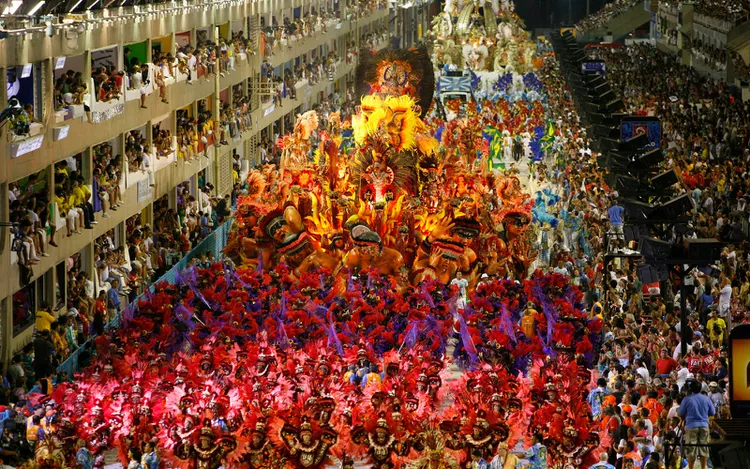Summary of Carnival Celebrations
Pulsating music, intricately decorated parade floats, a plethora of joyful dancers, and enough decadence to last a lifetime — these are the makings of a memorable Carnival. At the heart of every elaborate Carnival festival is an amalgamation of age-old tradition and ornate costuming paired with the occasionally satirical, tongue-in-cheek celebration. From New Orleans to Venice, no two cities’ spectacles are identical; rather, this annual parade of revelry ranges from the brightly-colored bead tossing along Bourbon Street to the grand masquerade balls that epitomize the Venetian style.
Carnival — with its origins predominantly in regions with vibrant Catholic religious traditions — marks the spirited season in the weeks leading up to Lent, a time often associated with fasting.
Carnival isn’t just a time to party; it is also an expressive outlet for artists to make thought-provoking statements with their floats as their platforms. These events attract hundreds of thousands of people each year — both tourists and locals alike — drawing inspiration from international current events in an ironic manner.
If you find yourself in need of some merriment, look no further than Carnival — just follow the beat of the heart-pounding music and join in.
Venice, Italy

Extravagant costumes and decorative masks make the Carnevale di Venezia one of Europe’s most elegant events. Carnevale, which attracts approximately three million people to Venice each year, is a celebration rooted in a series of historical reenactments and lavish masquerade balls. The two-week festival features an acrobatic water show at Darsena Grande and traditionally includes the famed Volo dell’Angelo (Flight of the Angel) zipline from the Campanile in St. Mark’s Square. Watch as the streets of Venice become a living museum of full period costumes and masked Venetian revelers during Carnevale.
New Orleans, Louisiana

It’s no surprise that New Orleans’ Mardi Gras celebration is the biggest of its kind in the U.S. Each year, the Mardi Gras krewes plan extensively detailed, themed parades that make their way down St. Charles Avenue. Escape the crowds of Bourbon Street and enjoy the best parade vantage spots in the surrounding neighborhoods while donning your beads thrown from the passing floats. The celebrations commence every January 6 with a customary Phunny Phorty Phellows Streetcar Ride along St. Charles Avenue, and the party is fully underway by Fat Tuesday, the festival season’s titular (and final) day. If the crowds are not your style, consider planning your trip for January when festivities begin to cross this once-in-a-lifetime experience off your bucket list.
Rio de Janeiro, Brazil
Perhaps the most iconic of all Carnival celebrations, Rio de Janeiro’s Carnival beckons visitors with its feathered, flashy costumes, distinctive samba rhythms, and long-standing traditions. With roots in West African traditions brought to Brazil by enslaved individuals, the samba style of music and dance is now embedded in Rio’s identity and is integral to Carnival. Rio’s parades take place in the Sambodromo, where only the top samba schools perform and compete after spending months preparing. The festival is celebrated in the days surrounding Ash Wednesday, during which millions partake in this rich cultural experience.
Cádiz, Spain

Recognized as the oldest Carnival celebration on mainland Spain, Cádiz Carnival originates from its relationship as a major trading partner with Venice in the 16th century. As one of the best-known festivals in Spain, Cádiz Carnival maintains its appeal through its sense of humor and sarcastic undertones. Fancy costumes, called tipos, are highly encouraged on the first Saturday of Carnival as the parades of coros, large groups of musicians, perform throughout the streets. Perhaps the most famous component of the festival is the singing groups, called chirigotas, who write and perform satirical lyrics that mock aspects of politics and pop culture.
Viareggio, Italy

This seaside Italian town is renowned for its politically charged, satirical floats. At approximately 20 meters tall and weighing around 40 tons each, these massive papier-mâché floats are unparalleled in their creativity (and size). Viareggio’s Carnevale floats, with a budget of €5 million, depict animated caricatures of both Italian and international political figures, and they provide critiques of current events and social injustice. As one of Italy’s most widely attended events, Viareggio’s six Carnevale parades draw in upwards of a million spectators each year.
Santa Cruz de Tenerife, Canary Islands

This lively festival kicks off with the crowning of the “Queen of the Carnival” in a gala featuring live music and elaborate costumes. Throughout the month-long Carnival, a multitude of daily parades, dances, and concerts keep visitors thoroughly entertained. Be sure to plan your visit to include the Daytime Carnival, also known as Sábado de Piñata, when the largest crowds gather in Santa Cruz. Conclusively, stick around until the end of the festivities — you will not want to miss the 24-hour party that ceremoniously ends with the burning and burial of an enormous papier-mâché sardine.
Salvador de Bahia, Brazil

The Salvador de Bahia Carnival, acclaimed as the second-largest Carnival in Brazil, is distinct from the Rio festivities in that samba parades do not play a role. However, due to Salvador de Bahia’s prominent Afro-Brazilian community, the parades embody an African cultural influence that has been preserved over time. In this vibrant atmosphere, crowds gather in the streets to watch the blocos (dancing blocks) perform throughout the main parade circuits.
Binche, Belgium

Named as a UNESCO Intangible Cultural Heritage event, Binche’s unique Carnival experience includes many folkloric traditions, including a ritual of throwing oranges for good luck. Participants can dress up as one of the festival’s traditional characters, such as Gilles, Peasants, Pierrots, and Harlequins. Gilles, the most beloved of all characters, are known for their quirky behaviors, wax masks, wooden shoes, and straw-filled costumes.





